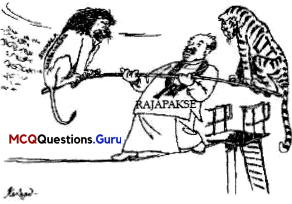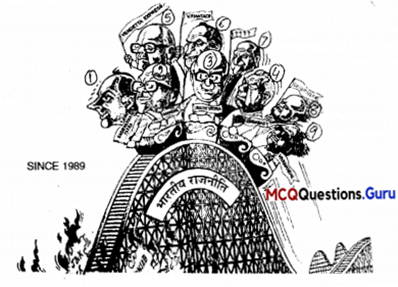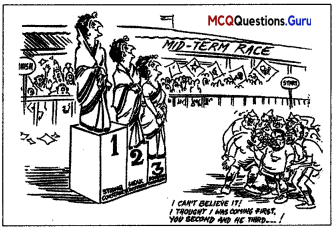United Nations and its Organizations Class 12 MCQs Questions with Answers
Question 1.
On the reforms of structures and processes, the biggest discussions has been on the functioning of the
(A) Security Council.
(B) Health of the infants
(C) Child mortality rate
(D) Nuclear weapon possession
Answer:
(A) Security Council.
Explanation:
The Security Council has primary responsibility, under the United Nations Charter, for the maintenance of international peace and security. It is for the Security Council to determine when and where a UN peace operation should be deployed.
![]()
Question 2.
The US, Japan, Germany, France, the UK, Italy, Canada and Russia are the:
(A) G8 members
(B) D8 members
(C) Cold War countries
(D) Dominating members
Answer:
(A) G8 members
Explanation:
The Group of Eight + Five (G8 + 5) was an international group that consisted of the leaders of the heads of government from the G8 nations (Canada, France, Germany, Italy, Japan, Russia, the United Kingdom, and the United States), plus the heads of government of the five ‚eading emerging economies (Brazil, China, India, Mexico, and South Africa).
![]()
Question 3.
The Secretary-General – Ban 1(1-Moon from South Korea is the …………… Secretary-General of the UN.
(A) Fifth
(B) Sixth
(C) Seventh
(D) Eighth
Answer:
(D) Eighth
Explanation:
Ban Ki-moon is a South Korean politician and diplomat who served as the eighth Secretary-General of the United Nations from January 2007 to December 2016.
![]()
Question 4.
Arrange the following in the chronological order:
(i) Establishment of Human Rights Council
(ii) Yalta Conference
(iii) Atlantic Charter
(iv) India join the UN
(A) (ii), (iv), (i), (iii)
(B) (iii), (ii), (iv), (i)
(C) (i), (ii), (iii), (iv)
(D) (ii), (iii), (iv), (i)
Answer:
(B) (iii), (ii), (iv), (i)
Explanation:
(i) The Atlantic Charter issued on 14 August 1941.
(ii) Yalta Conference held on 11 February 1945.
(iii) On 26 June 1945, India join the UN.
(iv) Human Rights Council established on 15 March 2006.
![]()
Question 5.
In 1992, the UN General Assembly adopted a resolution related to:
(A) UN Security Council
(B) UNESCO
(C) UNICEF
(D) World Bank
Answer:
Option (A) is correct.
Question 6.
The non-permanent members are elected in a manner so thai they represent at the of the world.
(A) races
(B) sections
(C) continents
(D) grievances
Answer:
Option (C) is correct.
![]()
Question 7.
The non-permanent members of the Security Coundl do not have the:
(A) Veto power
(B) Election power
(C) Military power
(D) Judiciary power
Answer:
Option (A) is correct.
Explanation:
The United Nations Security Council “Veto power” refers to the power of the five permanent members of the UN Security Council (China, France, Russia, the United Kingdom and the United States) to veto any “substantive” resolution.
![]()
Question 8.
With the disappearance of the Soviet Union, the US stands as the only:
(A) Major power
(B) Master power
(C) Superpower
(D) Inner power
Answer:
(C) Superpower
Question 9
draws the global media’s attention to …………. human rights abuses.
(A) Human Rights Power
(B) Human Rights Watch
(C) Human Rights People
(D) Human Rights Torch
Answer:
(B) Human Rights Watch
Explanation:
Human Rights Watch defends the rights of people worldwide. It scrupulously investigate abuses, expose the facts widely, and pressure those with power to respect rights and secure justice.
![]()
Question 10.
The UN is an body.
(A) indigenous
(B) imperfect
(C) impressive
(D) imperative
Answer:
(B) imperfect
Explanation:
In UN, the power of the US and its veto within the organisation split the rest of the world and to reduce opposition to its policies.
![]()
Question 11.
Which institution became the successor of the League of Nations?
(A) WHO
(B) UNICEF
(C) UN
(D) SAARC
Answer:
(C) UN
Explanation:
The UN was established in 1945 after the Second World War as successor to the League of Nations.
![]()
Question 12.
How many states signed United Nations Charter in 1945?
(A) 55
(B) 39
(C) 67
(D) 50
Answer:
(D) 50
Explanation:
The Charter was signed on 26 June 1945 by 50 countries; Filand signed on 15 October 1945.
Question 13.
What is the objective of UN?
(A) To prevent international conflict and facilitate co-operation among states.
(B) To boost the trade among the member nations.
(C) To procure the best medical help during the time of pandemic.
(D) All of the above.
Answer:
(A) To prevent international conflict and facilitate co-operation among states.
![]()
Explanation:
The UNs objective is to prevent international conflict and to facilitate cooperation among states. It was founded with the hope that it would act to stop the conflicts between states escalating into war and, if war broke out, to limit the extent of hostilities. The UN was intended to bring countries together to improve the prospects of sedal and economic development all over the world.
Question 14.
Which one of the following is the permanent member of UN?
(A) India
(B) China
(C) Sweden
(D) Ireland
Answer:
(B) China
Explanation:
The UN’s objective is to prevent international conflict and to facilitate cooperation among states. It was founded with the hope that it would act to stop the conflicts between states escalating into war and, if war broke out, to limit the extent of hostilities. The UN was intended to bring countries together to improve the prospects of social and economic development all over the world.
![]()
Question 14.
Which one of the following is the permanent member of UN?
(A) India
(B) China
(C) Sweden
(D) Ireland
Answer:
(B) China
Explanation:
The UN Security Council has five permanent members Le. China, France, Russia, the United Kingdom and the United States. the United Kingdom and the United Slates.
Question 16.
Who was the Secretary of UN in 1997?
(A) Bill Clinton
(B) General Kofi Annan
(C) George W Bush
(D) None of the above
Answer:
(B) General Kofi Annan
Explanation:
Kofi Annan (Ghana) held the office from January 1997 to December 2006.
![]()
Question 17.
When was UNESCO established?
(A) 6th November, 1946
(B) 5th November, 1945
(C) 4th November 1946
(D) 25th December 1946
Answer:
(C) 4th November 1946
Explanation:
The United Nations Educational, Scientific and Cultural Organization (UNESCO) was established on 4 November 1946 which aims to contribute to the building of a culture of peace, the eradication of poverty, sustainable development and intercultural dialogue through education, the sciences, 1 culture, communication and information.
![]()
Question 18.
Where is the head quarter of UNICEF?
(A) Tokyo
(B) Chicago
(C) Los Angeles
(D) New York
Answer:
(D) New York
Explanation:
UNICEF founded on 11 December, 1946 at New York, an agency responsible for providing humanitarian and developmental aid to children worldwide.
Question 19.
The WHO has played a leading role in …………
(A) public health achievement
(B) economic development
(C) children’s health
(D) resolving disputes among the nations
Answer:
(A) public health achievement
![]()
Explanation:
The World I lealth Organization (WHO) plays an essential role in the global governance of health and disease; due to its core global functions of establishing, monitoring and enforcing international norms and standards, and coordinating multiple actors toward common goals.
Question 20
Which U.N. agency concerned with the safety and peaceful use of nuclear technology?
(A) The UN Committee on Disarmament
(B) International Atomic Energy Agency
(C) UN International Safeguard Committee
(D) None of the above
Answer:
(A) The UN Committee on Disarmament
Explanation:
The main functions of the IAEA are to: encourage and assist research, development and practical application of atomic energy for peaceful uses throughout the world; establish and administer safeguards designed to ensure that such activity assisted by the Agency is not used to further any military purpose.
![]()
Question 21.
“The United Nations was not created to take humanity to the heaven, but to save it from the hell.” Who made this statement?
(A) Pt. Jawahar Lai Nehru
(B) Kofi Annan
(C) Ban Ki-moon
(D) Dag HammarskjoId
Answer:
(D) Dag HammarskjoId
Explanation:
By making this statement he means that International organisations are there to resolve the conflicts between countries without going to war. They can discuss contentious issues and find peaceful solutions.
Question 22.
Who is the single largest contributor to UN?
(A) China
(B) India
(C) US
(D) Europe
Answer:
(C) US
Explanation:
The United States is the largest provider of financial contributions to the United Nations, providing 22 percent of the entire UN budget in 2020.
![]()
Assertion and Reason Based MCQs
Directions:
In the following questions, a statement of Assertion (A) is followed by a statement of Reason (R). Mark the correct choice as:
(A) Both (A) and (R) are true, but (R) is the correct explanation of (A).
(B) Both (A) and (R) are true, but (R) is not the correct explanation of (A).
(C) (A) is true, but (R) is false.
(D) (A) is false, but (R) is true.
Question 1.
Assertion: Indeed, even though this is rarely noticed, most conflicts and differences are resolved without going to war.
Reason: The role of an international organization can be important in this context.
Answer:
(A) Both (A) and (R) are true, but (R) is the correct explanation of (A).
Explanation:
The role of international organizations is helping to set the international agenda, mediating political bargaining, providing a place for political initiatives and acting as catalysts for the coalition-formation. They facilitate cooperation and coordination among member nations.
![]()
Question 2.
Assertion: International organizations only solve the disputes among the countries.
Reason: International organizations are helpful in another way. Nations can usually see that there are some things they must do together. There are issues that are so challenging that they can only be dealt with when everyone works together. Disease is an example.
Answer:
(D) (A) is false, but (R) is true.
Explanation:
International organizations, apart from resolving disputes, can play an important role to deal with the other issues like poverty, pandemic or any natural disaster which needs international attention.
Question 3.
Assertion: The First World War encouraged the world to invest in an international organization to deal with conflict.
Reason: Many believed that such an organization would help the world to avoid war.
Answer:
(A) Both (A) and (R) are true, but (R) is the correct explanation of (A).
Explanation:
After witnessing the devastating effects of the war, countries of the world were in favour of building an organization which can negotiate in the disputes and find alternative ways to resolve the issues. UN is the result of such efforts.
![]()
Question 4.
Assertion: With the end of the Cold War, we can see that the UN may have a slightly different role.
Reason: As the United States and its allies emerged victorious, there was concern amongst many governments and peoples that the Western countries led by the US would be so powerful that there would be no check against their wishes and desires.
Answer:
(A) Both (A) and (R) are true, but (R) is the correct explanation of (A).
Explanation:
After the Cold War ended, there was a rapid increase in the number of peacekeeping operations. With a new consensus and a common sense of purpose, the Security Council authorized a total of 20 new operations between 1989 and 1994, raising the number of peacekeepers from 11,000 to 75,000.
![]()
Question 5.
Assertion: India supports an increase in the number of both permanent and non-permanent members of UN.
Reason: India itself also wishes to be a permanent member in a restructured UN.
Answer:
(B) Both (A) and (R) are true, but (R) is not the correct explanation of (A).
Explanation:
India joined the United Nations Security Council (UNSC) as a non-permanent member on January 4, beginning a tenure of two years. But New Delhi hopes that this time its presence in the UNSC will help move the organization towards the ultimate reform: a permanent seat on the UNSC for India.
Question 6.
Assertion: Despite India’s wish to be a permanent veto-wielding member of the UN, some countries question its inclusion. [K]
Reason: Neighboring Pakistan, with which India has troubled relations, is not the only country that is reluctant to see India become a permanent veto member of the Security Council.
Answer:
(B) Both (A) and (R) are true, but (R) is not the correct explanation of (A).
Explanation:
India desires to be a permanent member of the UN Security Council but many countries question the issue of India’s inclusion as a permanent member. It is not just Pakistan which is opposing India’s permanent membership, other countries are also questioning it on the basis of India’s nuclear weapons capability.
![]()
Question 7.
Assertion: Within the UN, the influence of the US is considerable. @
Reason: UN often supports US in every decision, be it even to attack any nation without the consent of UN.
Answer:
(C) (A) is true, but (R) is false.
Explanation:
The United States of America is a charter member of the United Nations and one of five permanent members of the UN Security Council. On matters of international peace and security, the UN’s role has been central to several top U.S. foreign policy priorities. UN peacekeepers help prevent conflict and protect civilians around the globe, at a fraction of the cost of sending U.S. troops.
Question 8.
Assertion: Amnesty International is an NGO that campaigns for the protection of human rights all over the world. [R]
Reason: It promotes respect for all the human rights in the Universal Declaration of Human Rights.
Answer:
(A) Both (A) and (R) are true, but (R) is the correct explanation of (A).
Explanation:
Amnesty has grown from seeking the release of political prisoners to upholding the whole spectrum of human rights. Our work protects and empowers people – from abolishing the death penalty to protecting sexual and reproductive rights, and from combating discrimination to defending refugees and migrants’ rights.
![]()
Question 9.
Assertion: The UN is an imperfect body, but without it the world would be worse off.
Reason: Given the growing connections and links between societies and issues-what we often call ‘interdependence’-it is hard to imagine how more than seven billion people would live together without an organization such as the UN.
Answer:
(A) Both (A) and (R) are true, but (R) is the correct explanation of (A).
Explanation: The UN accomplishes this by working to prevent conflict, helping parties in conflict make peace, deploying peacekeepers, and creating the conditions to allow peace to hold and flourish. The UN Security Council has the primary responsibility for international peace and security.
![]()
Question 10.
Assertion: The UN is not a great balance to the US.
Reason: The UN can and has served to bring the US and the rest of the world into discussions over various issues.
Answer:
(B) Both (A) and (R) are true, but (R) is not the correct explanation of (A).
Question 11.
Assertion: US power cannot be easily checked.
Reason: US can undermine UN legally if she has to attack any of the countries of the world.
Answer:
(C) (A) is true, but (R) is false.
Explanation: There is no such clause in UN that allows US to undermine UN. But we have seen in the past that US has been dominating UN, e.g., US attack on Iraq, 2003.
![]()
Question 12.
Assertion: The fact that the UN is physically located within the US territory gives Washington additional sources of influence.
Reason: Within the UN, the influence of the US is considerable.
Answer:
(A) Both (A) and (R) are true, but (R) is the correct explanation of (A).
Case-Based MCQs
I. Study the cartoon given below carefully and answer the questions that follow.
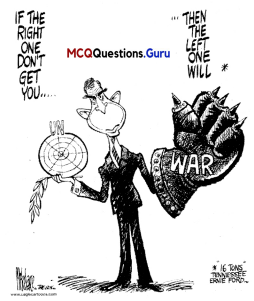
Question 1.
What does this cartoon depict?
(A) UN’s influence on the world
(B) USA’s influence on UN
(C) US Hegemony
(D) None of the above
Answer:
(B) USA’s influence on UN
![]()
Question 2.
What have been the reasons for immense influence of US on UN?
(A) USA’s economic superiority
(B) USA’s weapon capacity
(C) UN’s head quarter is in USA and USA’s financial contribution to UN.
(D) All of the above
Answer:
(C) UN’s head quarter is in USA and USA’s financial contribution to UN.
Explanation:
Although the United States continues to play a leadership role at the UN, it has also accumulated massive arrears in its payments to the UN, owing the world organization approximately $1 billion, far more than any other member state.
Question 3.
Why this cartoon is not relevant today?
(A) Because all the countries have their powerful organizations.
(B) US is now not as powerful as it used to as the new centres of power emerged.
(C) Iraq and Mghanistan war ha affected US economy.
(D) UN has become more powerful.
Answer:
(B) US is now not as powerful as it used to as the new centres of power emerged.
![]()
Question 4.
How has US dominated the world?
(A) By its trade and commerce
(B) By its technology
(C) By its advancement in space research.
(D) By dominating military, economy and cultural aspects of the other nations.
Answer:
(D) By dominating military, economy and cultural aspects of the other nations.
II. Read the following paragraph and answer the questions that follows:
The International Monetary Fund (IMF) is an international organisation that oversees those financial institutions and regulations that act at the international level. The IMF has 189 member countries (as on 12 April 2016) but they do not enjoy an equal say. The G-7 members US (16.52%), Japan (6.15%), Germany (5.32%), France (4.03%), UK (4.03%), Italy (3.02%) and Canada (2.22%) have 41.29% of the votes. China (6.09%), India (2.64%), Russia (2.59%) Brazil (2.22%) and Saudi Arabia (2.02%) are the other major members.
The World Bank was created during the Second World War in 1944. Its activities are focused on the developing countries. It works for human development (education, health), agriculture and rural development (irrigation, rural services), environmental protection (pollution reduction, establishing and enforcing regulations), infrastructure (roads, urban regeneration, and electricity) and governance (anti-corruption, development of legal institutions).
It provides loans and grants to the member-countries. In this way, it exercises enormous influence on the economic policies of developing countries. It is often criticised for setting the economic agenda of the poorer nations, attaching stringent conditions to its loans and forcing free market reforms.
![]()
Question 1.
As per April 2016, how many members did IMF have?
(A) 187
(B) 189
(C) 188
(D) 190
Answer:
(B) 189
Question 2.
What is the share of Canada in IMF?
(A) 2.22%
(B) 2.23%
(C) 2.20%
(D) 3.00%
Answer:
(A) 2.22%
![]()
Question 3.
When was the inception of World Bank?
(A) 1949
(B) 1950
(C) 1944
(D) 1952
Answer:
(C) 1944
Explanation:
Founded in 1944, the International Bank for Reconstruction and Development-soon called the World Bank-has expanded to a closely associated group of five development institutions. Originally, its loans helped rebuild 1 countries devastated by World War II.
![]()
Question 4.
The World Bank is criticized for what?
(A) For not providing loans to poorer nations.
(B) For interfering in the internal issues of the developing countries.
(C) For poor guidance on economic issues.
(D) For setting the economic agenda of the poorer nations, attaching stringent conditions to its loans and forcing free market reforms.
Answer:
(D) For setting the economic agenda of the poorer nations, attaching stringent conditions to its loans and forcing free market reforms.
![]()
Explanation:
Critics of the World Bank argue that structural adjustment loans are a mechanism of forcing free market economics on countries through coercion. Countries with a debt crisis, whatever their other characteristics, agree to the bank’s package of legal and economic reforms, and the bank agrees to lend them money.
III. Study the picture given below and answer the questions that follow:
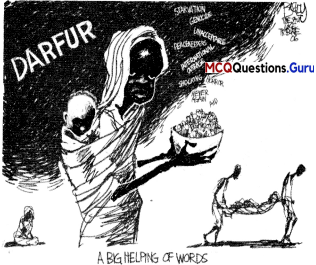
Question 1.
What is represented by the cartoon?
(A) Poverty in the third world countries
(B) Poverty in South African countries
(C) Humanitarian crisis in Darfur, Sudan.
(D) All of the above
Answer:
(C) Humanitarian crisis in Darfur, Sudan.
Explanation:
Darfur, the western region of Sudan, has been in a state of humanitarian crisis since 2003. The current conflict in Darfur is complex, caused by a host of political, social, economic and environmental problems. Hundreds of thousands of people have died and more than 8.5 million people are affected by the crisis.
![]()
Question 2.
What type of crises is shown in the cartoon?
(A) Pandemic
(B) Epidemic
(C) Starvation and genocide
(D) War crisis
Answer:
(C) Starvation and genocide
Question 3.
What message is conveyed by the cartoon?
(A) That international NGOs only debated about the issue and never sent any aid
(B) Urgent requirement of help
(C) International attention over the issue
(D) Deteriorating conditions of Sudan
Answer:
(A) That international NGOs only debated about the issue and never sent any aid
Question 4.
What was the cause of Darfur crisis?
(A) War
(B) Famine
(C) Environmental degradation and violence
(D) Colonization of the country
Answer:
(C) Environmental degradation and violence
Explanation:
Conflict between pastoralists and sedentary farmers, caused in part by environmental pressures and changing land ownership patterns, was an important cause of the Darfur violence.
IV. Read the following paragraph and answer the questions that follows:
India has supported the restructuring of the UN on several grounds. It believes that a strengthened and revitalised UN is desirable in a changing world. India also supports an enhanced role for the UN in promoting development and cooperation among states. India believes that development should be central to the UN’s agenda as it is a vital precondition for the maintenance of international peace and security.
![]()
One of India’s major concerns has been the composition of the Security Council, which has remained largely static while the UN General Assembly membership has expanded considerably. India considers that this has harmed the representative character of the Security Council. It also argues that an expanded Council, with more representation, will enjoy greater support in the world community. India supports an increase in the number of both permanent and non-permanent members.
Its representatives have argued that the activities of the Security Council have greatly expanded in the past few years. The success of the Security Council’s actions depends upon the political support of the international community. Any plan for restructuring of the Security Council should, therefore, be broad-based. For example, the Security Council should have more developing countries in it.
Question 1.
According to India, how the development should be if it is proposed by UN?
(A) Central to the UN’s agenda
(B) Central to the superpowers of the world
(C) Central to the developing nations
(D) All of the above
Answer:
(A) Central to the UN’s agenda
![]()
Question 2.
What has been one of India’s major concerns?
(A) Terrorism
(B) Corruption
(C) The Security Council
(D) Genera Assembly
Answer:
(C) The Security Council
Explanation:
India has said that the U.N. Security Council is finding itself unable to act effectively to address increasingly complex issues of international peace and security as it lacked inclusivity of those who need to be members of the powerful organ of the world body.
![]()
Question 3.
Where India suggests UN should include more countries to represent?
(A) In the Security Council
(B) In the General Assembly
(C) In UN
(D) All of the above
Answer:
(A) In the Security Coun
![]()
Question 4.
How, according to India, should be the plan for restructuring of the Security Council?
(A) Broad based
(B) Large scale
(C) More elaborative
(D) None of the above
Answer:
(A) Broad based
V. Read the following case and answer the questions that follows:
International Organizations (IOs) are formal institutional structures transcending national boundaries which are created by multilateral agreement among nation-states. Their purpose is to foster international cooperation in areas such as: security, law, economic, social matters and diplomacy.
IOs are subdivided between Intergovernmental Organizations (IGOs) and Non-Governmental Organizations (NGOs); Intergovernmental Organizations are entities created with sufficient organizational structure and autonomy to provide formal, ongoing, multilateral processes of decision making between states, along with the capacity to execute the collective of their member (states).
NGOs are non-state voluntary organizations formed by individuals to achieve a common purpose, often oriented beyond themselves or to the public good. The development and expansion of these large representative bodies date back to the end of the World War II, where there was a need for world reconstruction through International Relations.
![]()
Since then, there has been an incremental rise of organizations that work on different socio-political and economic aspects with various and specific aims in approaching states, societies, groups and individuals.
Based on these key definitions, it is an attempt to explain how important are IOs and the extent to which they have an impact on global politics and international relations through an analysis of two main IR scholar theories namely Realism and Liberalism.
Moreover, to understand the impact of IOs, these theories will be explored and analysed through contexts of different and conflicting realist and liberalists thinkers upon their view on these institutional structures. It will also distinguish and compare the two theories and determine which is more relevant to the contemporary world international relations.
Question 1.
What is the purpose of International Organisations?
(A) To foster economic ties of the developed nations
(B) To foster international cooperation
(C) To eradicate terrorism
(D) To foster health care
Answer:
(B) To foster international cooperation
Explanation:
The role of international organizations is helping to set the international agenda, mediating political bargaining, providing a place for political initiatives and acting as catalysts for the coalition- formation. They facilitate cooperation and coordination among member nations.
![]()
Question 2.
What are the sub divisions of International Organisations?
(A) State-governmental and Non-governmental
(B) Private and Public
(C) Governmental and Public
(D) None of the above
Answer:
(D) None of the above
Explanation:
It is usual to distinguish between three main types of “international organization”, namely: inter-governmental organizations, international non-governmental organizations, and multinational enterprises.
Question 3.
Where can we find the development and expansion of these organisations?
(A) At the end of first world war
(B) At the beginning of second world war
(C) At the end of second world war
(D) In 2003
Answer:
(C) At the end of second world war
![]()
Question 4.
Which two main IR scholars theories are mentioned here?
(A) Realism and Liberalism
(B) Capitalism and Socialism
(C) Feminism and Humanism
(D) Human Rights and Welfare
Answer:
(A) Realism and Liberalism
Explanation:
Traditionally there have been two central theories of IR: liberalism and realism. Although they have come under great challenge from other theories, they remain central to the discipline. At its height, liberalism in IR was referred to as a ‘utopian’ theory and is still recognised as such to some degree today.
